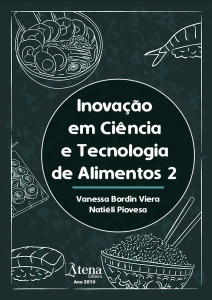
CARACTERIZAÇÃO DAS PROPRIEDADES TECNOLÓGICAS DA FARINHA DE ORA-PRO-NÓBIS (Pereskia aculeata mil.)
As plantas alimentícias não
convencionais (PANCS) estão espalhadas por
toda fauna e flora brasileira, tendo um grande
potencial para complementar a alimentação
das pessoas, diversificar cardápios e
nutrientes, sendo também fonte de renda.
Em destaque temos a Pereskia aculeata Mill.
pertencente à família cactácea, conhecida
por ser uma planta de quintal, chamada
popularmente como ora-pro-nobis (OPN). O
objetivo geral foi obter e caracterizar físicoquímica e tecnologicamente farinha de OPN.
Foi avaliada a hortaliça não convencional OPN
adquirida em uma floricultura local na cidade
de Belém/PA. A determinação da composição
físico-química foi feita em duplicata. Para
realização da caracterização de composição
centesimal, foi utilizado um termo higrômetro
para medição da aW, para pH se fez uso de
Phmêtro, umidade através de uma estufa de
secagem a 105ºC, proteínas totais pelo método
de Kjeldhal, lipídeos por Bligh Dayer, cinzas
com secagem em mufla a 550ºC, carboidratos
por diferença. Para propriedade tecnológica,
foi utilizado o método para a capacidade de
absorção gordura, capacidade de absorção de
água, a propriedade emulsificante, propriedade
espumante, o poder de inchamento e índice
de solubilidade. Comparando os resultados
obtidos em relação a composição centesimal
com os já existentes na literatura nota-se
diferenças relevantes em relação a umidade,
mas se adequa ao exigido pela ANVISA, com
o limite para umidade de até 15% em farinhas.
Quanto aos lipídios observou-se valores
baixos em relação a resultados encontrados
na literatura, resultados já esperado pois as
hortaliças não são consideradas fontes de
lipídeos. Os resultados obtidos de carboidratos
foram superiores aos entrados na literatura. Em
relação a proteínas, houve grande diferença
em comparação a estudos já existentes na
literatura, onde o presente trabalho obteve
6,22g±0,05% de proteínas, que pode ser
explicada por diferenças de fatores ambientais.
A atividade de água obteve media de 0,57%,
conforme a literatura a atividade de água
para farinhas vegetais pode ser até 0,72%. A
amostra analisada apresentou pH muito acido. O teor de cinzas achado neste estudo
mostrou-se baixo. Em relação as análise das propriedades tecnológicas foi visto
indicativo de solubilidade em água, potencial em absorver gordura, e não apresentou
propriedade espumante e emulsificante. Diante dos resultados obtidos podemos
concluir que esta farinha apresentou potencial benéfico para consumo com alto teor
proteico e de carboidratos, e baixo teor de lipídeos. De acordo com as características
tecnológicas, esta farinha apresentou alto teor na capacidade de absorção de gordura,
não sendo indicada para preparações como empanados. Por conta dos seus índices
de solubilidade e capacidade de absorção de água pode ser utilizada em pães. Seu
discreto poder de inchamento não a torna alternativa para preparações como mingais.
A baixa capacidade de emulsão e a não formação de espuma, exclui esta farinha de
preparação que precise destas propriedades.
CARACTERIZAÇÃO DAS PROPRIEDADES TECNOLÓGICAS DA FARINHA DE ORA-PRO-NÓBIS (Pereskia aculeata mil.)
-
DOI: 10.22533/at.ed.9971909109
-
Palavras-chave: Pereskia aculeata; Propriedades tecnológicas; Farinha;
-
Keywords: Pereskia aculeata; Technological properties; Flour;
-
Abstract:
Unconventional food plants (UFPs) are scattered throughout the Brazilian
fauna and flora, and have a great potential to complement people’s food, diversify menus
and nutrients, being also a source of income. Highlights include Pereskia aculeata Mill.
belonging to the Cactus family, known as a backyard plant, popularly called ora-pronobis (OPN). The general objective was to obtain and characterize physicochemical
and technologically OPN flour. The non-conventional vegetable OPN acquired in a local
floriculture in the city of Belém/PA was evaluated. The physical-chemical composition
was determined in duplicate. To characterize the centesimal composition, a hygrometer
term was used to measure the aW, for pH it was used Phmêtro, humidity through a
drying oven at 105ºC, total proteins by the Kjeldhal method, lipids by Bligh Dayer, ashes
with muffle drying at 550ºC, carbohydrates by difference. For technological property,
used the method for fat absorption capacity, water absorption capacity, emulsifying
property . sparkling property, the swelling power and solubility index. Comparing the
results obtained in relation to the centesimal composition with those already existing in
the literature, relevant differences in relation to humidity are noted, but it is adequate
to that required by ANVISA, with a limit for humidity of up to 15% in flours. As for
lipids, low values were observed in relation to the results found already existing in the
literature, results already expected because vegetables are not considered sources
of lipids. The results obtained from carbohydrates were higher than those obtained
in literature. Regarding proteins, there was a big difference compared to existing
studies in the literature, the present study obtained 6.22g±0.05% protein, which can
be explained by differences in environmental factors. Water activity averaged 0.57%,
which according to the literatute, the water activity for vegetable flour can be up to
0.72%. The sample analysed had a very acidic pH. The ash content found in this study
was low. In relation to the analysis of the technological properties, it was seen as
indicative of water solubility, potential to absorb fat, and did not present any sparkling
or emulsifying properties. In view of the obtained results we can conclude that this
flour presented beneficial potential for consumption with high protein and carbohydrate
content, and low lipid content. According to the technological characteristics, this flour
had a high content in the capacity of fat absorption, not being indicated for preparations
such as empanadas. Because of its solubility indexes and water absorption capacity
it can be used in breads. Its discreet swelling power does not make it an alternative
to preparations such as mingals. The low emulsifiability and the absence of foaming
exclude this preparation flour that needs these properties.
-
Número de páginas: 15
- Márlia Barbosa Pires.
- Ana Karoline Silva Dos Santos.
- Keila Garcia Da Silva.


